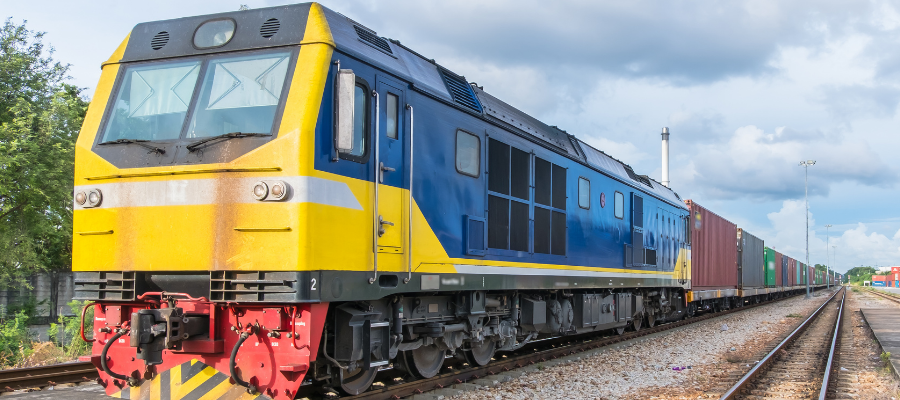🕒 Article read time: 3 minutes
Rail and air: making the connection

With transport responsible for 27% of UK greenhouse gas (GHG) emissions in 2019 and road transport accounting for almost 90% of domestic transport emissions, maximising the use of other transport modes like rail (which is responsible for just 1.4% of GHG emissions) in logistics is essential for the UK to reach its decarbonisation goals.
The good news is that rail freight is growing – figures released by the Office of Road and Rail show a 36.5% increase in the amount of freight carried by rail between April and June 2021 when compared to the same period in 2020. However, there remains an opportunity for multimodal freight systems in the UK to be enhanced and capitalised upon.
INVESTING IN INTERMODAL CONNECTIONS
Ensuring there are strong links between airports and rail networks can enhance the efficiency of logistics while removing vehicles from the UK’s congested roads; robust onward connectivity is also vital to attract international trade. Poor rail connectivity in the North of England has been an obstacle to productivity and economic growth for decades. While this was on course to change with the construction of the Northern Powerhouse Rail (NPR) project – a major strategic rail programme designed to improve regional, national, and international connectivity in the North. However, the government's recent decision to scrap the eastern leg of HS2 now places the future connectivity of industry in the North in the balance.
“Logistics UK is examining the government's rationale closely to decipher what the long-term impact will be on rail freight and its potential growth in the UK,” said Mags Simpson, Head of Policy Engagement at Logistics UK, “and will be raising the concerns of our members with politicians and administrators.”
MANCHESTER AIRPORT TO JOIN NPR NETWORK
Better news came in the announcement that Manchester Airport – which handles around 100,000 tonnes of import and export freight and mail annually – is intended as an integral part of the NPR network, with an integrated NPR/HS2 station to be built in the city.
“It is crucial that the programme is used to maximise all opportunities to grow rail freight in the region,” Simpson said, “freight must be considered as a vital element in the design and management of any new, or enhanced, rail links.”
To ensure the NPR programme is supporting the government’s ambition to transition the UK to a net zero emission economy by 2050, these rail links should be electrified wherever possible. While much of the UK’s existing trainline is electrified, there are notable gaps in the North, such as the Manchester-Leeds-York route; but this situation is starting to be rectified.
SCOTTISH BUSINESSES RELIANT ON ENGLISH TRANSPORT LINKS
Further north, many businesses in Scotland are reliant on rail and road links from southern England’s airports and ports for export and import activity; according to Network Rail, more than seven thousand tonnes of products pass over the England-Scotland border via rail every 24 hours. Although Scottish ports, such Inverness, are used regularly, a large proportion of the goods leaving Scotland for non-UK destinations are moved by ships and planes which leave from England, rather than from Scotland itself. The most significant airport for the Scottish supply chain is Heathrow Airport in London; the most used ports also lie in southern England: Felixstowe, London Gateway, Southampton, and Dover. Improving Scotland’s aviation and shipping supply chain is therefore not exclusively about airports and ports in the country; the government and MSPs understand this relationship and the trend in international shipping and aviation to base activities out of a few key central locations in northern Europe.
RAIL MAIN MODE FOR ENGLISH-SCOTTISH TRADE
The M6 is the only motorway connection into Scotland. While the A1 is another important corridor, it has a lower proportion of HGVs on its roads compared to the M6 and a slower total traffic flow overall; rail is the main mass-transport mode across the England-Scotland border, according to the March 2021 Union Connectivity Review Interim Report. With this mind, improving England-Scotland rail links is vital to maximise the efficiencies of Scotland’s supply chain.
BUSINESS GROUP SUPPORTS PLAN FOR GROWTH
Logistics UK supports Network Rail’s Industry Growth plan for Rail Freight in Scotland; primarily, the objective is to grow rail freight by 7.5% between April 2019 and March 2024.
“We are working closely with the Scottish Freight Joint Board Group (SFJB) to support its work with Transport Scotland to monitor progress against this growth strategy,” Simpson said, “All members of the Group recognise the importance of the government and the owners and operators of freight modes working together to identify solutions to support effective multi-modal systems.”
Logistics UK is also working with the newly established Great British Railways organisation to ensure that the decisions made by the new body maximise the opportunities rail freight can bring to the economy and environment.
“Widespread rail-air connectivity is essential to grow the use of rail freight in the UK while improving supply chain efficiency and attracting international trade,” Simpson concludes, “it is also vital to support the government’s ‘levelling up’ agenda. Logistics UK will continue working with its members, government and other stakeholders to help ensure multimodal systems are maximised.”
*www.logistics.org.uk/rail
Published On: 25/11/2021 16:00:50

Comments Section
If you are a Logistics UK member login to add comments.